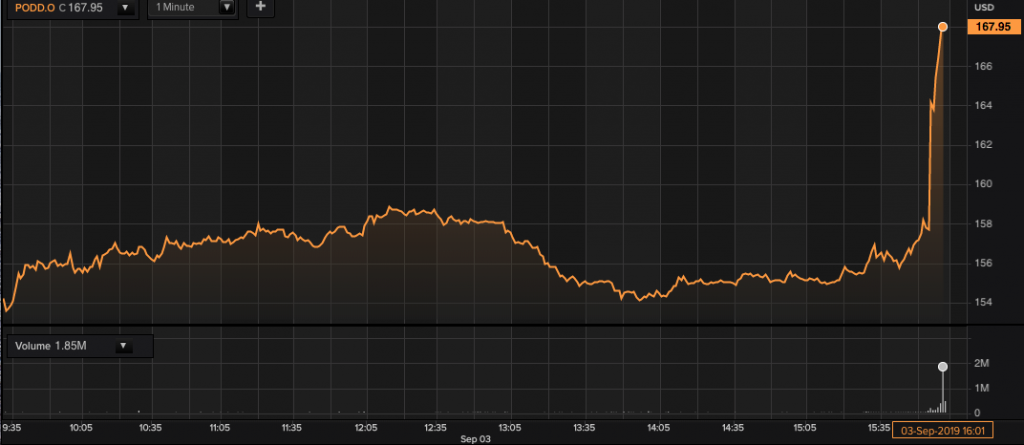On September 3rd, Insulet issued $800mm (including greenshoe) of new 7-year convertible bonds, and bought back $225mm principal amount of its old convertibles due 2021. Matthews South was not involved in the transaction. JWood was the independent advisor to the company.
The Insulet financing highlights the need for careful management of the complicated market dynamics of a simultaneous liability management and new issue transactions. For Insulet, poor transaction structuring proved to be costly.
Highlights
- In the last 20 minutes of trading, Insulet’s stock price rallied 7.5% on extremely heavy volume
- The hedging activity around the repurchase and new issue transactions resulted in a significant imbalance that required investors to buy shares into the close
- We estimate the net buying activity to be 1.5mm shares (this is net of the short selling by hedge funds in the new issue)
- It is likely that much of this was purchased in the last 20 minutes, leading to the 7.5% rally
- The stock appreciation artificially increased the repurchase price on the outstanding bonds; we estimate this cost the company ~$11mm (net of the benefit of pricing the new deal off a higher stock price)
- There were numerous ways that this concentrated buying could have been prevented
Unnatural trading into the close?

In the last 20 minutes of trading on the day of marketing, Insulet’s stock price rallied from $156.18 to close at $167.83 (+7.5%, total move for the day +8.9%), on extremely heavy volume (more than 2.3mm shares out of 5.7mm total for the day traded at the close). By 20 minutes into trading on the following day, the stock was back at $163 (down 2.9%), and it closed at $157.12.
What happened?
In a convertible issuance plus simultaneous bond buyback, the market needs to accommodate both short selling from investors in the new transaction and short covering by investors of the repurchased bonds.
On an $800mm new convertible with an up 100% call spread, we estimate that ~1.2mm shares would need to be shorted by new investors assuming 80% hedge fund allocations.
In the buyback, Insulet bought $225mm principal amount of its 2021 bonds for a price of 289% of par, or ~$650mm aggregate, comprising $455mm of cash and $195mm of stock (1.16mm shares). Because the bonds were deep in the money, we expect that the holders were short about the full number of shares underlying the bonds, or about 3.85mm total shares. Investors would have been able to use the 1.16mm share issued by the company to cover part of this short position, but otherwise would need to buy ~2.7mm shares to cover their residual short position.
Assuming the existing investors could seamlessly buy the 1.2mm shares shorted by new investors, it still left about 1.5mm shares to be bought in the market — which may explain the significant end of day run-up.
Did it matter?
At first glance the 7.5% jump into the close was helpful to the company’s economics on the new issue transaction (raising both the conversion price and the upper strike of the call spread). However, the repurchase of existing notes was effectively an economic repurchase of the shares underlying that old bond, so the higher stock price made that buyback transaction more expensive.
Comparing the two, the $800mm new issue transaction economically has ~3.5mm underlying shares. However, because of the conversion premium and call spread up 100%, a Black-Scholes model would attribute only a 40 – 50% chance of ultimate conversion. This means that ~3.5mm total shares underlying the new convertible is economically equivalent to about 1.7mm shares today on a probability-weighted basis.
The old bonds, although only $225mm in principal amount represented more shares (3.85mm) given the lower conversion price of $58.37. Taking into account the 1.16mm shares issued in the buyback, the repurchase was an economic stock buyback of 2.7mm shares.
So while the 1.7mm economic share issuance benefited from the stock price increase, the 2.7mm net buyback was harmed by it. The net economic impact was an additional cost of $11mm (~$11 per share cost on the 1.0mm net share repurchase).
What Could Have Been Done Differently?
In simultaneous liability management and new issue convertible transactions, costly disruptive trading is best avoided by balancing the shares shorted by new investors precisely against the shares to be bought by old investors (taking into account any call spreads as well). This can be done by flexing: (1) the ratio of hedge fund to outright investors participating in the new offering, (2) the amount of old bonds bought back, (3) the mix of cash and stock that old investors receive in the buyback or (4) having a short averaging period to set the bond buyback price.
In the Insulet case, the excess buying activity could have been mitigated by reducing the number of bonds repurchased or by buying those bonds with a lower proportion of cash and more shares.
By contrast, in the transactions for Alteryx and PROS on which we advised, the amount of bonds repurchased was targeted to ensure that shares bought to cover existing shorts precisely offset the amount of stock shorted by new investors. As a result, the stock price impact on the day of marketing was +0.7% and -0.8%, respectively.
